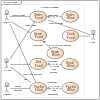| The topic of this article may not meet Misplaced Pages's general notability guideline. Please help to demonstrate the notability of the topic by citing reliable secondary sources that are independent of the topic and provide significant coverage of it beyond a mere trivial mention. If notability cannot be shown, the article is likely to be merged, redirected, or deleted. Find sources: "Node" UML – news · newspapers · books · scholar · JSTOR (October 2015) (Learn how and when to remove this message) |
| This article needs additional citations for verification. Please help improve this article by adding citations to reliable sources. Unsourced material may be challenged and removed. Find sources: "Node" UML – news · newspapers · books · scholar · JSTOR (February 2009) (Learn how and when to remove this message) |

A node in the Unified Modeling Language (UML) is a computational resource upon which UML artifacts may be deployed for execution.
There are two types of nodes: device nodes and execution environments.
- A device represents hardware devices: a physical computational resource with processing capability upon which UML artifacts may be deployed for execution. Devices may be complex (i.e., they may consist of other devices).
- An execution environment represents software containers (such as operating systems, JVM, servlet/EJB containers, application servers, portal servers, etc.) This is a node that offers an execution environment for specific types of components that are deployed on it in the form of deployable artifacts.
Execution environments can be nested. Nodes can be interconnected through communication paths to define network structures. A communication path is an "association between two DeploymentTargets, through which they are able to exchange signals and messages".
Usage
When modeling devices, it is possible to model them in several different ways:
- Name a device using the type and make, for instance "IBM RS6000", "HP 9000".
- Name a device using its intended function, for instance "Database Server", "High Speed Switch"
- Name a device using the operating system deployed on it, for instance "Linux Server", "Solaris Server".
Use tagged values to specify characteristics of devices / execution environments, for instance "Memory=2GB", "Disk Space=32GB", "Version=2.5.1".
References
- ^ "Nodes". Unified Modeling Language 2.5.1. OMG Document Number formal/2017-12-05. Object Management Group Standards Development Organization (OMG SDO). December 2017. p. 387, 396, 403, 657.
- ^ OMG (2008). OMG Unified Modeling Language (OMG UML), Superstructure, V2.1.2 Archived 2010-09-23 at the Wayback Machine p.199-210.
| Unified Modeling Language | |||||||||||||
|---|---|---|---|---|---|---|---|---|---|---|---|---|---|
| Actors |
|  | |||||||||||
| Concepts |
| ||||||||||||
| Diagrams |
| ||||||||||||
| Derived languages | |||||||||||||
| Other topics | |||||||||||||
This Unified Modeling Language article is a stub. You can help Misplaced Pages by expanding it. |